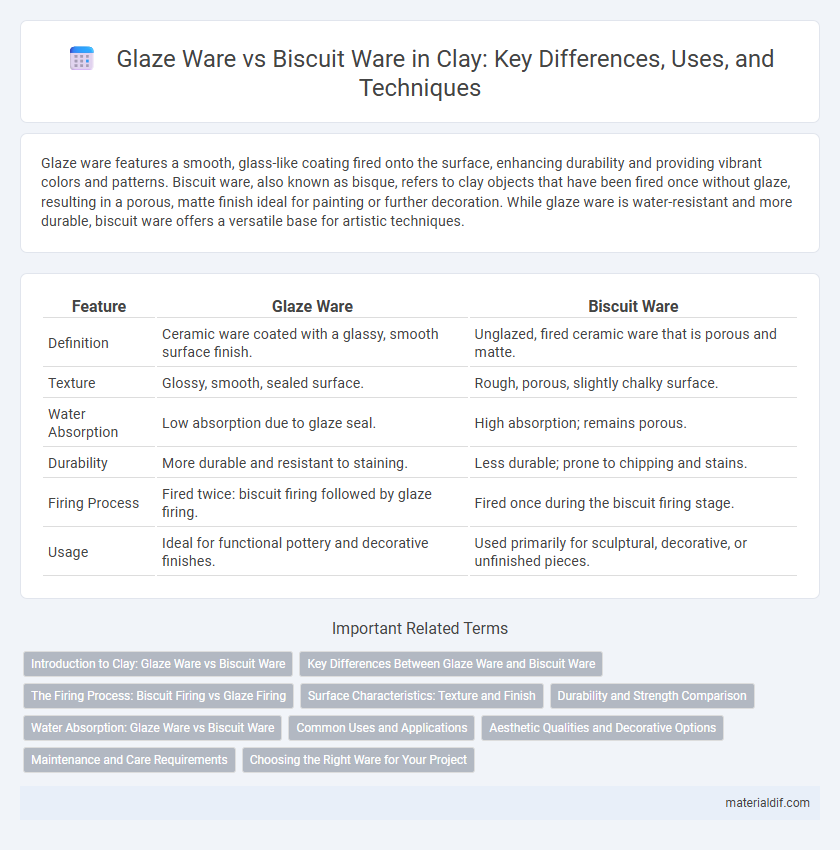Glaze ware features a smooth, glass-like coating fired onto the surface, enhancing durability and providing vibrant colors and patterns. Biscuit ware, also known as bisque, refers to clay objects that have been fired once without glaze, resulting in a porous, matte finish ideal for painting or further decoration. While glaze ware is water-resistant and more durable, biscuit ware offers a versatile base for artistic techniques.
Table of Comparison
| Feature | Glaze Ware | Biscuit Ware |
|---|---|---|
| Definition | Ceramic ware coated with a glassy, smooth surface finish. | Unglazed, fired ceramic ware that is porous and matte. |
| Texture | Glossy, smooth, sealed surface. | Rough, porous, slightly chalky surface. |
| Water Absorption | Low absorption due to glaze seal. | High absorption; remains porous. |
| Durability | More durable and resistant to staining. | Less durable; prone to chipping and stains. |
| Firing Process | Fired twice: biscuit firing followed by glaze firing. | Fired once during the biscuit firing stage. |
| Usage | Ideal for functional pottery and decorative finishes. | Used primarily for sculptural, decorative, or unfinished pieces. |
Introduction to Clay: Glaze Ware vs Biscuit Ware
Glaze ware refers to ceramic pieces coated with a glass-like substance that fuses during firing, providing a smooth, waterproof, and often colorful surface. Biscuit ware, or bisque, consists of unglazed, fired clay that is porous and matte, typically serving as the initial stage before glazing. Understanding the distinction between glaze ware and biscuit ware is essential for mastering ceramic techniques and achieving desired aesthetic and functional outcomes.
Key Differences Between Glaze Ware and Biscuit Ware
Glaze ware features a glass-like coating that seals the ceramic surface, enhancing durability and creating a smooth, often glossy finish, while biscuit ware remains unglazed and porous after its first firing. Biscuit ware serves as a base, offering a matte texture ideal for decoration or further glazing in subsequent firings. The key difference lies in their surface properties and purpose: glaze ware is finished and waterproof, whereas biscuit ware is in a preparatory stage, awaiting glaze for protection and aesthetic enhancement.
The Firing Process: Biscuit Firing vs Glaze Firing
Biscuit ware undergoes an initial firing called biscuit firing, where clay objects are fired at lower temperatures around 900-1000degC to harden the clay without vitrifying it. Glaze ware is fired at higher temperatures, typically between 1200-1300degC, during the glaze firing process, which melts the glaze and vitrifies the clay, creating a glassy, waterproof surface. This two-step firing process ensures that biscuit ware remains porous and ready to absorb glaze, while glaze firing finalizes the piece with a durable, decorative finish.
Surface Characteristics: Texture and Finish
Glaze ware features a smooth, glossy surface achieved by applying and firing a glassy coating, which enhances its durability and water resistance. Biscuit ware, also known as bisque, has a matte, porous surface resulting from an initial firing without glaze, often preferred for its raw, tactile texture. The contrast in surface finish directly affects both the aesthetic appeal and functional properties of the ceramic piece.
Durability and Strength Comparison
Glaze ware possesses a vitrified surface that significantly enhances its durability and resistance to water absorption compared to biscuit ware, which remains porous and fragile after the initial firing. Biscuit ware, being unglazed, is more susceptible to chipping and requires careful handling during production and use, whereas glaze ware's glassy coating provides a protective barrier that improves strength and longevity. The firing temperature and glaze composition further influence the overall robustness of glaze ware, making it the preferred choice for functional ceramics exposed to wear and moisture.
Water Absorption: Glaze Ware vs Biscuit Ware
Glaze ware exhibits significantly lower water absorption due to its vitrified, glass-like surface that seals the pores, making it less porous and more waterproof compared to biscuit ware. Biscuit ware, being unglazed and porous, absorbs water readily, which affects its durability and suitability for holding liquids. The water absorption rate of biscuit ware can be several times higher than that of glaze ware, highlighting the importance of glazing in producing functional ceramic items.
Common Uses and Applications
Glaze ware is commonly used for functional ceramics such as dinnerware, tiles, and decorative pieces due to its glass-like surface that provides waterproofing and enhanced durability. Biscuit ware, being unglazed, is often employed in artistic and sculptural applications where surface texture and the ability to absorb finishes or paints are desired. Both types serve distinct purposes in pottery, with glaze ware favored for everyday use and biscuit ware preferred for aesthetic and tactile qualities.
Aesthetic Qualities and Decorative Options
Glaze ware offers a smooth, glossy finish that enhances color vibrancy and provides a durable, water-resistant surface ideal for artistic detailing. Biscuit ware, being unglazed and porous, presents a matte, raw texture that emphasizes natural clay qualities and allows for intricate carving or painting before firing. The choice between glaze and biscuit ware significantly impacts aesthetic appeal, with glaze ware favoring bright, polished looks and biscuit ware supporting rustic, earthy designs.
Maintenance and Care Requirements
Glaze ware requires careful handling to avoid chipping and cracking, with regular cleaning using non-abrasive materials to maintain its glossy finish. Biscuit ware, being unglazed, is more porous and can absorb moisture, demanding protection from prolonged exposure to water and stains, often necessitating sealing treatments for durability. Both types benefit from gentle storage and avoiding sudden temperature changes to extend their lifespan.
Choosing the Right Ware for Your Project
Glaze ware features a glassy surface achieved by firing clay with a glaze, providing durability and a smooth, waterproof finish ideal for functional pottery like dishes and vases. Biscuit ware, also known as bisque, is unglazed and fired once to a porous state, perfect for painting, decorating, or further glazing in subsequent firings. Selecting between glaze ware and biscuit ware depends on project goals--choose glaze ware for ready-to-use, finished pieces or biscuit ware for customizable, decorative work.
Glaze Ware vs Biscuit Ware Infographic

 materialdif.com
materialdif.com